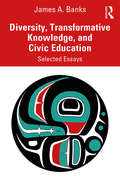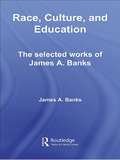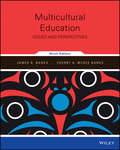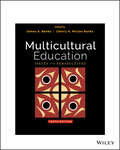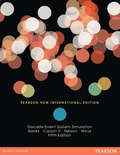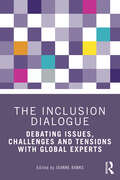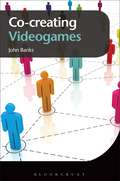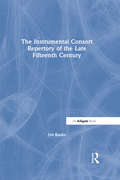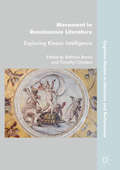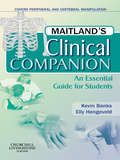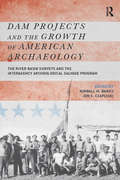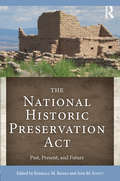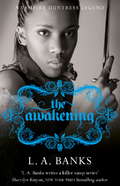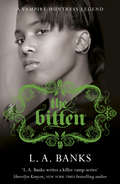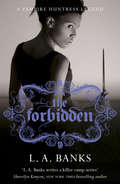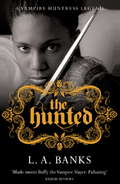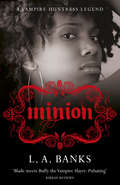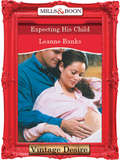- Table View
- List View
Diversity, Transformative Knowledge, and Civic Education: Selected Essays
by James A. BanksThe essays collected in this book, by James A. Banks, a foundational figure in the field of multicultural education, illuminate the interconnection between the author’s work on knowledge construction and civic education. In pieces both poignant and personal, Banks shares some of his most groundbreaking and innovative work. Diversity, Transformative Knowledge, and Civic Education aims to unpack the "citizenship-education dilemma," whereby education programs strive to teach students democratic ideals and values within social, economic, political, and educational contexts that contradict justice, equality, and human rights. For change to take place, students need to internalize democratic values, by directly experiencing them in transformative classrooms and schools that are envisioned and described in this book. Drawn from Banks’ formidable canon, this collection highlights the conceptual, curricular, and pedagogical issues related to this dilemma, and signals a fundamental shift toward transformative citizenship education. Students, scholars and educators in the fields of multicultural education, civic education, social studies education, comparative education, and the foundations of education will find this book to be a valuable resource for discussion and discovery.
Diversity, Transformative Knowledge, and Civic Education: Selected Essays
by James A. BanksThe essays collected in this book, by James A. Banks, a foundational figure in the field of multicultural education, illuminate the interconnection between the author’s work on knowledge construction and civic education. In pieces both poignant and personal, Banks shares some of his most groundbreaking and innovative work. Diversity, Transformative Knowledge, and Civic Education aims to unpack the "citizenship-education dilemma," whereby education programs strive to teach students democratic ideals and values within social, economic, political, and educational contexts that contradict justice, equality, and human rights. For change to take place, students need to internalize democratic values, by directly experiencing them in transformative classrooms and schools that are envisioned and described in this book. Drawn from Banks’ formidable canon, this collection highlights the conceptual, curricular, and pedagogical issues related to this dilemma, and signals a fundamental shift toward transformative citizenship education. Students, scholars and educators in the fields of multicultural education, civic education, social studies education, comparative education, and the foundations of education will find this book to be a valuable resource for discussion and discovery.
Race, Culture, and Education: The Selected Works of James A. Banks
by James A. BanksConsidered the father of multicultural education in the US and known throughout the world as one of the field’s most important founder, theorist and researcher, James A. Banks has collected here twenty-one of his most important and best works from across the span of his career. Drawing out the major themes that have shaped the field of multicultural education as well as outlining the development of Banks’ own career, these articles, chapters and papers focus on eight key issues: black studies and the teaching of history research and research issues teaching ethnic studies teaching social studies for decision-making and citizen action multiethnic education and school reform multicultural education and knowledge construction the global dimensions of multicultural education democracy, diversity and citizenship education. The last part of the book consists of a selected bibliography of all Banks’ publications over his forty-year career, as a source of further reading on each of these pivotal ideas.
Race, Culture, and Education: The Selected Works of James A. Banks
by James A. BanksConsidered the father of multicultural education in the US and known throughout the world as one of the field’s most important founder, theorist and researcher, James A. Banks has collected here twenty-one of his most important and best works from across the span of his career. Drawing out the major themes that have shaped the field of multicultural education as well as outlining the development of Banks’ own career, these articles, chapters and papers focus on eight key issues: black studies and the teaching of history research and research issues teaching ethnic studies teaching social studies for decision-making and citizen action multiethnic education and school reform multicultural education and knowledge construction the global dimensions of multicultural education democracy, diversity and citizenship education. The last part of the book consists of a selected bibliography of all Banks’ publications over his forty-year career, as a source of further reading on each of these pivotal ideas.
Multicultural Education: Issues and Perspectives
by James A. Banks Cherry A. McGee BanksThere is a wide and growing ethnic, cultural, social-class, and linguistic gap between many of the nation’s teachers and their students. Multicultural Education: Issues and Perspectives, 9th edition, is designed to help current and future educators acquire the concepts, paradigms, and explanations needed to become effective practitioners in culturally, racially, linguistically, and social-class diverse classrooms and schools. An important goal of the 9th edition is to help educators attain a sophisticated understanding of the concept of culture and to view race, class, gender, social class, and exceptionality as interacting concepts rather than as separate and distinct.
Multicultural Education: Issues And Perspectives (Multicultural Education Ser. #No. 20)
by James A. Banks Cherry A. McGee BanksDiscrete-Event System Simulation: Pearson New International Edition
by Jerry Banks Barry L. Nelson John S. Carson David M. NicolFor junior- and senior-level simulation courses in engineering, business, or computer science.While most books on simulation focus on particular software tools, Discrete Event System Simulation examines the principles of modeling and analysis that translate to all such tools. This language-independent text explains the basic aspects of the technology, including the proper collection and analysis of data, the use of analytic techniques, verification and validation of models, and designing simulation experiments. It offers an up-to-date treatment of simulation of manufacturing and material handling systems, computer systems, and computer networks. Students and instructors will find a variety of resources at the associated website, www.bcnn.net/, including simulation source code for download, additional exercises and solutions, web links and errata.
The Inclusion Dialogue: Debating Issues, Challenges and Tensions with Global Experts
by Joanne BanksThe Inclusion Dialogue: Debating Issues, Challenges and Tensions with Global Experts brings together a series of global expert views on inclusive education, revealing the evolving tensions in this research area and highlighting future directions. Based on fascinating and unique conversations with leading academic experts across the globe, Joanne Banks uses in-depth interviews to examine current debates in special and inclusive education and provides a clear overview of the key tensions which impact policy and practice across different national contexts. Her book also highlights how inclusive education policies do not always translate into inclusive practices in our schools. The dialogue presented in this accessible text provides readers with insights into our conceptual understanding of inclusion within the context of the United Nations Convention on the Rights of People with Disabilities. Through these informal discussions, this book is ideal for academics and researchers working in the area of inclusive and special education, for educators wishing to create more inclusive environments for their students, and for policy-makers seeking to understand what inclusive education looks like on the ground.
The Inclusion Dialogue: Debating Issues, Challenges and Tensions with Global Experts
by Joanne BanksThe Inclusion Dialogue: Debating Issues, Challenges and Tensions with Global Experts brings together a series of global expert views on inclusive education, revealing the evolving tensions in this research area and highlighting future directions. Based on fascinating and unique conversations with leading academic experts across the globe, Joanne Banks uses in-depth interviews to examine current debates in special and inclusive education and provides a clear overview of the key tensions which impact policy and practice across different national contexts. Her book also highlights how inclusive education policies do not always translate into inclusive practices in our schools. The dialogue presented in this accessible text provides readers with insights into our conceptual understanding of inclusion within the context of the United Nations Convention on the Rights of People with Disabilities. Through these informal discussions, this book is ideal for academics and researchers working in the area of inclusive and special education, for educators wishing to create more inclusive environments for their students, and for policy-makers seeking to understand what inclusive education looks like on the ground.
Co-creating Videogames
by John BanksCo-creativity has become a significant cultural and economic phenomenon. Media consumers have become media producers. This book offers a rich description and analysis of the emerging participatory, co-creative relationships within the videogames industry. Banks discusses the challenges of incorporating these co-creative relationships into the development process. Drawing on a decade of research within the industry, the book gives us valuable insight into the continually changing and growing world of video games.
The Instrumental Consort Repertory of the Late Fifteenth Century
by Jon BanksThough individual pieces from the late fifteenth century are widely accepted as being written for instruments rather than voices, they are traditionally considered as exceptions within the context of a mainstream of vocal polyphony. After a rigorous examination of the criteria by which music of this period may be judged to be instrumental, Dr Jon Banks isolates all such pieces and establishes them as an explicit genre alongside the more commonly recognized vocal forms of the period. The distribution of these pieces in the manuscript and early printed sources of the time demonstrate how central instrumental consorts were to musical experience in Italy at this time. Banks also explores the social background to Italian music-making, and particularly the changing status of instrumentalists with respect to other musicians. Convincing evidence is put forward in particular for the lute ensemble to be a likely performance context for many of the surviving sources. The book is not intended to be a prescriptive account for the role of instruments in late medieval music, but instead restores an impressive but largely overlooked consort repertory to its rightful place in the history of music.
The Instrumental Consort Repertory of the Late Fifteenth Century
by Jon BanksThough individual pieces from the late fifteenth century are widely accepted as being written for instruments rather than voices, they are traditionally considered as exceptions within the context of a mainstream of vocal polyphony. After a rigorous examination of the criteria by which music of this period may be judged to be instrumental, Dr Jon Banks isolates all such pieces and establishes them as an explicit genre alongside the more commonly recognized vocal forms of the period. The distribution of these pieces in the manuscript and early printed sources of the time demonstrate how central instrumental consorts were to musical experience in Italy at this time. Banks also explores the social background to Italian music-making, and particularly the changing status of instrumentalists with respect to other musicians. Convincing evidence is put forward in particular for the lute ensemble to be a likely performance context for many of the surviving sources. The book is not intended to be a prescriptive account for the role of instruments in late medieval music, but instead restores an impressive but largely overlooked consort repertory to its rightful place in the history of music.
Movement in Renaissance Literature: Exploring Kinesic Intelligence
by Kathryn Banks Timothy ChestersThis book investigates how writers and readers of Renaissance literature deployed ‘kinesic intelligence’, a combination of pre-reflective bodily response and reflective interpretation. Through analyses of authors including Petrarch, Rabelais, and Shakespeare, the book explores how embodied cognition, historical context, and literary style interact to generate and shape responses to texts. It suggests that what was reborn in the Renaissance was partly a critical sense of the capacities and complexities of bodily movement. The linguistic ingenuity of humanism set bodies in motion in complex and paradoxical ways. Writers engaged anew with the embodied grounding of language, prompting readers to deploy sensorimotor attunement. Actors shaped their bodies according to kinesic intelligence molded by theatrical experience and skill, provoking audiences to respond to their most subtle movements. An approach grounded in kinesic intelligence enables us to re-examine metaphor, rhetoric, ethics, gender, and violence. The book will appeal to scholars and students of English, French, and Italian Renaissance literature and to researchers in the cognitive humanities, cognitive sciences, and theatre studies.
Movement in Renaissance Literature: Exploring Kinesic Intelligence
by Kathryn Banks Timothy ChestersThis book investigates how writers and readers of Renaissance literature deployed ‘kinesic intelligence’, a combination of pre-reflective bodily response and reflective interpretation. Through analyses of authors including Petrarch, Rabelais, and Shakespeare, the book explores how embodied cognition, historical context, and literary style interact to generate and shape responses to texts. It suggests that what was reborn in the Renaissance was partly a critical sense of the capacities and complexities of bodily movement. The linguistic ingenuity of humanism set bodies in motion in complex and paradoxical ways. Writers engaged anew with the embodied grounding of language, prompting readers to deploy sensorimotor attunement. Actors shaped their bodies according to kinesic intelligence molded by theatrical experience and skill, provoking audiences to respond to their most subtle movements. An approach grounded in kinesic intelligence enables us to re-examine metaphor, rhetoric, ethics, gender, and violence. The book will appeal to scholars and students of English, French, and Italian Renaissance literature and to researchers in the cognitive humanities, cognitive sciences, and theatre studies.
Maitland's Clinical Companion E-Book: An Essential Guide for Students
by Kevin Banks Elly HengeveldThis reference is ideal for students who need support during their neuromusculoskeletal clinical practice in areas such as communication, clinical reasoning, examination and assessment. It is a vital source for understanding the role of mobilization and manipulation in helping to maximize the recovery, rehabilitation and functioning of patients with movement-related disorders. The principles of the Maitland Concept of Manipulative Physiotherapy are applied to each body region so as to guide the student through to the appropriate selection, application and progression of mobilization and manipulation techniques within the context of contemporary physiotherapeutic rehabilitation. A vital companion to the classic texts – Maitland's Vertebral Manipulation and Maitland's Peripheral Manipulation – which promotes a patient-centred approach to neuromusculoskeletal disorders.Learning objectives and self-assessment questions in every chapter enables students to reflect on their knowledgeCase studies highlights key aspects of the concepts to clinical practiceClinical profiles for common neuromusculoskeletal conditionsTechniques described and accompanied by over 500 imagesPicture key to identify types of examination, decision-making and techniques within the text
Dam Projects and the Growth of American Archaeology: The River Basin Surveys and the Interagency Archeological Salvage Program
by Kimball M. Banks Jon S. CzaplickiThe Smithsonian Institution’s River Basin Surveys and the Interagency Archeological Salvage Program were the most ambitious archaeological projects ever undertaken in the United States. Administered by the National Park Service from 1945–1969, the programs had profound effects—methodological, theoretical, and historical—on American archaeology, many of which are still being felt today. They stimulated the public’s interest in heritage preservation, led to the passage of the National Historic Preservation Act, served as the model for rescue archaeology in other countries, and helped launch the “New Archaeology.” This book examines the impacts of these two programs on the development of American archaeology.
Dam Projects and the Growth of American Archaeology: The River Basin Surveys and the Interagency Archeological Salvage Program
by Kimball M. Banks Jon S. CzaplickiThe Smithsonian Institution’s River Basin Surveys and the Interagency Archeological Salvage Program were the most ambitious archaeological projects ever undertaken in the United States. Administered by the National Park Service from 1945–1969, the programs had profound effects—methodological, theoretical, and historical—on American archaeology, many of which are still being felt today. They stimulated the public’s interest in heritage preservation, led to the passage of the National Historic Preservation Act, served as the model for rescue archaeology in other countries, and helped launch the “New Archaeology.” This book examines the impacts of these two programs on the development of American archaeology.
The National Historic Preservation Act: Past, Present, and Future
by Kimball M. Banks Ann M. ScottAssessing fifty years of the National Historic Preservation Act (NHPA), passed in 1966, this volume examines the impact of this key piece of legislation on heritage practices in the United States. The editors and contributing authors summarize how we approached compliance in the past, how we approach it now, and how we may approach it in the future. This volume presents how federal, state, tribal entities, and contractors in different regions address compliance issues; examines half a century of changes in the level of inventory, evaluation and mitigation practices, and determinations of eligibility; describes how the federal and state agencies have changed their approach over half a century; the Act is examined from the Federal, SHPO, THPO, Advisory Council, and regional perspectives. Using case studies authored by well-known heritage professionals based in universities, private practice, tribes, and government, this volume provides a critical and constructive examination of the NHPA and its future prospects. Archaeology students and scholars, as well heritage professionals, should find this book of interest.
The National Historic Preservation Act: Past, Present, and Future
by Kimball M. Banks Ann M. ScottAssessing fifty years of the National Historic Preservation Act (NHPA), passed in 1966, this volume examines the impact of this key piece of legislation on heritage practices in the United States. The editors and contributing authors summarize how we approached compliance in the past, how we approach it now, and how we may approach it in the future. This volume presents how federal, state, tribal entities, and contractors in different regions address compliance issues; examines half a century of changes in the level of inventory, evaluation and mitigation practices, and determinations of eligibility; describes how the federal and state agencies have changed their approach over half a century; the Act is examined from the Federal, SHPO, THPO, Advisory Council, and regional perspectives. Using case studies authored by well-known heritage professionals based in universities, private practice, tribes, and government, this volume provides a critical and constructive examination of the NHPA and its future prospects. Archaeology students and scholars, as well heritage professionals, should find this book of interest.
The Awakening: A Vampire Huntress Legend Book (VAMPIRE HUNTRESS LEGEND #2)
by L.A. BanksA battle is brewing in the Underworld and at the centre of it all is Damali Richards. Damali is a vampire huntress, but not just any huntress - she is the Millenium: a vampire huntress so powerful the vampire world is prepared to go to war over who should possess her.Fallon Nuit, a rogue vampire, in league with demons, is determined to claim her but then an ex-lover turned vampire enters the fray. But Damali is not about to let anyone, or anything, fight over her without having her own say.
The Bitten: A Vampire Huntress Legend Book (VAMPIRE HUNTRESS LEGEND)
by L.A. BanksShe is a woman who lives between pleasure and pain - the pure, scintillating pleasure of the flesh and the kind of pain that has rocked the world and left it strewn with chaos set to a hip-hop beat. Her name is Damali Richards. And when she makes love to a master vampire, it changes everything in a struggle between good and evil - with the future of humanity hanging in the balance ... THE BITTENIn L.A. Banks' astounding new Vampire Huntress novel, an unforgettable scene of seduction touches off a violent race around the world - and into a realm beneath us. For Damali, once a pawn, has been given a new, pulsating power of her own - bitten by lover and vampire extraordinaire Carlos Rivera. Between them, they know how high the stakes have risen. A powerful lord of darkness has hijacked a mystical key containing the blood of Christ. And for a world where blood runs like a river, one drop of this blood will be the end ...
The Forbidden: A Vampire Huntress Legend Book (VAMPIRE HUNTRESS LEGEND)
by L.A. BanksThe devil is a dead-beat dad and his consort Lilith couldn't care less. A stolen embryo stirs in Lilith's womb and a plan pulses through her veins: To unleash her child from the gates of hell - as soon as she destroys the only two vampire hunters who can possibly stop her ...Damali Richards is a woman-child in a world running with blood, depravity and demons. Turned by her lover, Carlos Rivera, and brought back again, Damali clings to the one measure of purity that was handed down to her through generations of the wise, gifted and strong. Now, through the power of magic, through the ache of desire and the touch of her lover, Damali is on a journey from the streets of Philadelphia to the ancient earth of Africa. With a small army, with Carlos and with her own mad skills, she might just save the world from the demon seductress who wants her and her faith obliterated - before Armageddon begins ...
The Hunted: A Vampire Huntress Legend Book (VAMPIRE HUNTRESS LEGEND #3)
by L.A. BanksA Neteru - a hunter or a huntress - is born every thousand years to lead the Warriors of Light as they fight agaisnt the dark realms. Damali Richards lives in modern day L.A. and she is the huntress.And she's been to hell and back. Literally. A war between the Vampires should have been good for mankind but Damali believes she has lost her vampire lover Carlos in the carnage.And then comes word of a spree of horrific killings in Brazil. The war between the vampires has opened a door from the darker realms of hell and something has come though ...
Minion: A Vampire Huntress Legend Book (VAMPIRE HUNTRESS LEGEND)
by L.A. BanksA Vampire Huntress is born every thousand years - someone to lead the Warriors of Light as they fight against the Dark Realms. Damali Richards, born on to the streets of L.A., brought up in the Projects, is our Huntress.The Hunters and the Vampires are fighting in hell and on our streets and Damali will lead the Hunters in the Final War.L.A. Banks' novels are steeped in both vampire lore and hip-hop culture and feature a vivid cast of black heroines and heroes. This is dark fantasy for the hip-hop generation.
Expecting His Child (Mills And Boon Desire Ser.)
by Leanne BanksMartina Logan dangerously shared a passionate affair with her family's nemesis, handsome Noah Coltrane. But when she became pregnant, Martina was determined to have the baby alone. So, armed with baby booties, she stood her ground.
